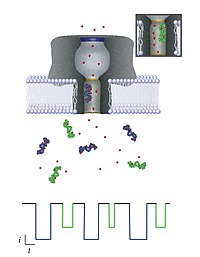
Photo from wikipedia
Abstract In this paper, we investigate the electrical transport of two-terminal trilayer graphene and silicene flake (bilayer and monolayer nanoribbons) in the absence and presence of nanopores and DNA molecule… Click to show full abstract
Abstract In this paper, we investigate the electrical transport of two-terminal trilayer graphene and silicene flake (bilayer and monolayer nanoribbons) in the absence and presence of nanopores and DNA molecule by using Green’s function method. The passage of the DNA molecule through the nanopore significantly changes the transport properties. It is found that passing double-stranded DNA through trilayer graphene nanopore (tGNP) causes the metal-semiconductor quantum phase transition and in trilayer silicene nanopore (tSNP) increases the energy gap. The transport properties of DNA strands passing through nanopores depend on the thickness of the nanopores, the leads and the location of the electrodes. It has been shown that in tSNP and tGNP the energy gap with monolayer connections is larger than that of the bilayer connections. The computational results show reduction in electron transmission for both types of nanopores. These results can be useful for making a DNA sequencing devices.
Journal Title: Chemical Physics
Year Published: 2021
Link to full text (if available)
Share on Social Media: Sign Up to like & get
recommendations!